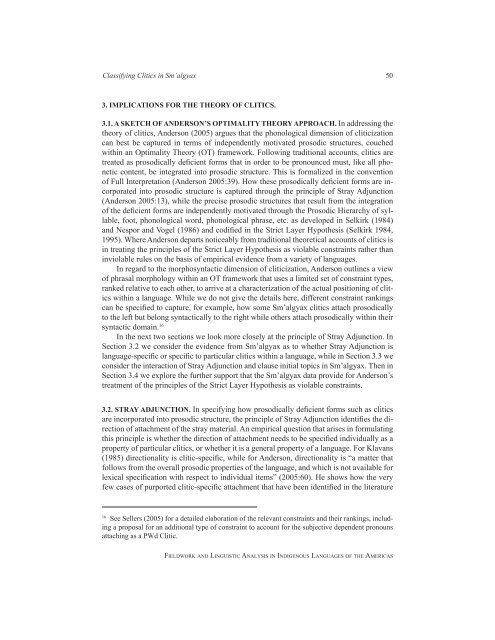Fieldwork and Linguistic Analysis in Indigenous ... - ScholarSpace
Fieldwork and Linguistic Analysis in Indigenous ... - ScholarSpace
Fieldwork and Linguistic Analysis in Indigenous ... - ScholarSpace
Create successful ePaper yourself
Turn your PDF publications into a flip-book with our unique Google optimized e-Paper software.
Classify<strong>in</strong>g Clitics <strong>in</strong> Sm’algyax 50<br />
3. IMPLICATIONS FOR THE THEORY OF CLITICS.<br />
3.1. A SKETCH OF ANDERSON’S OPTIMALITY THEORY APPROACH. In address<strong>in</strong>g the<br />
theory of clitics, Anderson (2005) argues that the phonological dimension of cliticization<br />
can best be captured <strong>in</strong> terms of <strong>in</strong>dependently motivated prosodic structures, couched<br />
with<strong>in</strong> an Optimality Theory (OT) framework. Follow<strong>in</strong>g traditional accounts, clitics are<br />
treated as prosodically deficient forms that <strong>in</strong> order to be pronounced must, like all phonetic<br />
content, be <strong>in</strong>tegrated <strong>in</strong>to prosodic structure. This is formalized <strong>in</strong> the convention<br />
of Full Interpretation (Anderson 2005:39). How these prosodically deficient forms are <strong>in</strong>corporated<br />
<strong>in</strong>to prosodic structure is captured through the pr<strong>in</strong>ciple of Stray Adjunction<br />
(Anderson 2005:13), while the precise prosodic structures that result from the <strong>in</strong>tegration<br />
of the deficient forms are <strong>in</strong>dependently motivated through the Prosodic Hierarchy of syllable,<br />
foot, phonological word, phonological phrase, etc. as developed <strong>in</strong> Selkirk (1984)<br />
<strong>and</strong> Nespor <strong>and</strong> Vogel (1986) <strong>and</strong> codified <strong>in</strong> the Strict Layer Hypothesis (Selkirk 1984,<br />
1995). Where Anderson departs noticeably from traditional theoretical accounts of clitics is<br />
<strong>in</strong> treat<strong>in</strong>g the pr<strong>in</strong>ciples of the Strict Layer Hypothesis as violable constra<strong>in</strong>ts rather than<br />
<strong>in</strong>violable rules on the basis of empirical evidence from a variety of languages.<br />
In regard to the morphosyntactic dimension of cliticization, Anderson outl<strong>in</strong>es a view<br />
of phrasal morphology with<strong>in</strong> an OT framework that uses a limited set of constra<strong>in</strong>t types,<br />
ranked relative to each other, to arrive at a characterization of the actual position<strong>in</strong>g of clitics<br />
with<strong>in</strong> a language. While we do not give the details here, different constra<strong>in</strong>t rank<strong>in</strong>gs<br />
can be specified to capture, for example, how some Sm’algyax clitics attach prosodically<br />
to the left but belong syntactically to the right while others attach prosodically with<strong>in</strong> their<br />
syntactic doma<strong>in</strong>. 16<br />
In the next two sections we look more closely at the pr<strong>in</strong>ciple of Stray Adjunction. In<br />
Section 3.2 we consider the evidence from Sm’algyax as to whether Stray Adjunction is<br />
language-specific or specific to particular clitics with<strong>in</strong> a language, while <strong>in</strong> Section 3.3 we<br />
consider the <strong>in</strong>teraction of Stray Adjunction <strong>and</strong> clause <strong>in</strong>itial topics <strong>in</strong> Sm’algyax. Then <strong>in</strong><br />
Section 3.4 we explore the further support that the Sm’algyax data provide for Anderson’s<br />
treatment of the pr<strong>in</strong>ciples of the Strict Layer Hypothesis as violable constra<strong>in</strong>ts.<br />
3.2. STRAY ADJUNCTION. In specify<strong>in</strong>g how prosodically deficient forms such as clitics<br />
are <strong>in</strong>corporated <strong>in</strong>to prosodic structure, the pr<strong>in</strong>ciple of Stray Adjunction identifies the direction<br />
of attachment of the stray material. An empirical question that arises <strong>in</strong> formulat<strong>in</strong>g<br />
this pr<strong>in</strong>ciple is whether the direction of attachment needs to be specified <strong>in</strong>dividually as a<br />
property of particular clitics, or whether it is a general property of a language. For Klavans<br />
(1985) directionality is clitic-specific, while for Anderson, directionality is “a matter that<br />
follows from the overall prosodic properties of the language, <strong>and</strong> which is not available for<br />
lexical specification with respect to <strong>in</strong>dividual items” (2005:60). He shows how the very<br />
few cases of purported clitic-specific attachment that have been identified <strong>in</strong> the literature<br />
16 See Sellers (2005) for a detailed elaboration of the relevant constra<strong>in</strong>ts <strong>and</strong> their rank<strong>in</strong>gs, <strong>in</strong>clud<strong>in</strong>g<br />
a proposal for an additional type of constra<strong>in</strong>t to account for the subjective dependent pronouns<br />
attach<strong>in</strong>g as a PWd Clitic.<br />
fieldwork <strong>and</strong> l<strong>in</strong>guistic analysis <strong>in</strong> <strong>in</strong>digenous languages of the americas

















